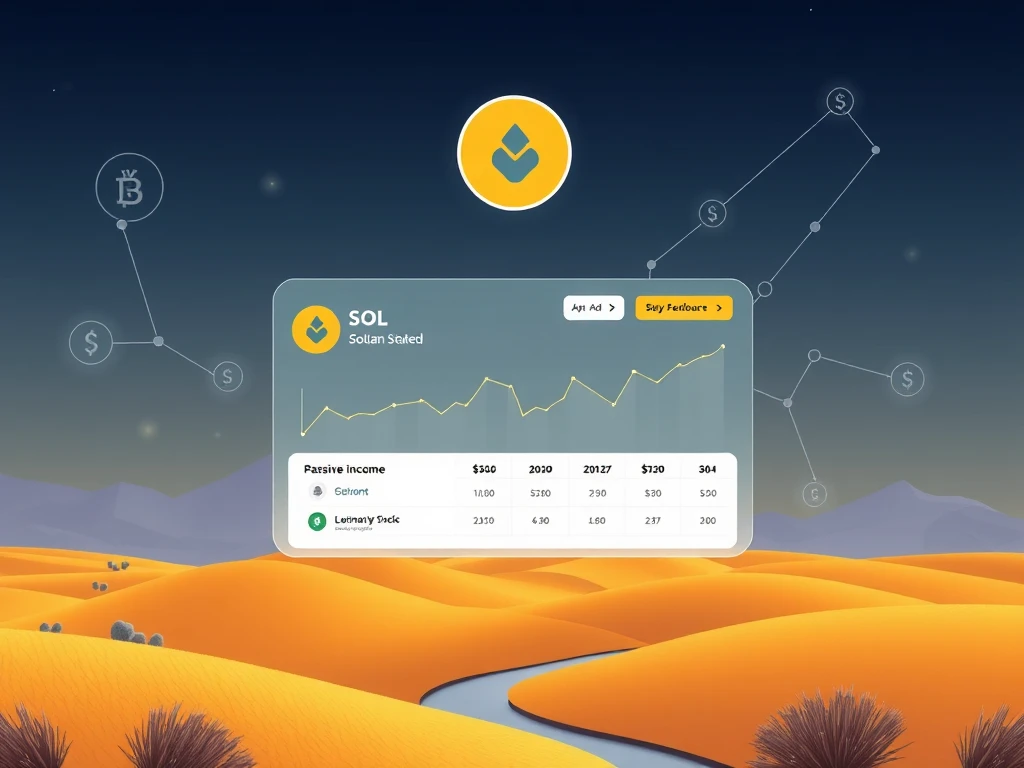Unlock Profitable Staking: How to Stake Solana (SOL) in 2025 – A Beginner’s Guide

Are you looking for ways to grow your cryptocurrency holdings without actively trading? If you hold Solana (SOL), staking offers a compelling opportunity to earn passive income. As we look towards 2025, understanding how to **stake Solana** effectively is key for maximizing your returns and participating in the network’s growth.
What is Staking SOL and Why Do It?
Solana is a high-performance blockchain utilizing a unique combination of Proof-of-Stake (PoS) and Proof-of-History (PoH). This hybrid approach allows for fast transactions and enables holders of its native token, SOL, to participate in network security and governance through staking.
Staking SOL involves locking your tokens within a compatible wallet to support the network’s operations. In return, you receive rewards. Here’s why you might consider **staking SOL**:
- **Earn Passive Income:** Receive staking rewards, typically paid out every two days (an epoch). The reward rate depends on factors like the total amount of SOL staked, the network’s inflation rate, and validator performance.
- **Network Participation:** By staking, you help secure the Solana network and can participate in governance decisions by delegating your vote to a validator.
- **Contribute to Security:** Staking makes the network more robust against attacks, contributing to a stable environment for all users.
While there’s no strict minimum to **stake Solana**, a practical minimum around 0.01 SOL is often cited due to transaction fees. Staking is generally considered a relatively safe way to engage with crypto ecosystems compared to active trading.
Solana Staking Guide: Methods Explained
Before you dive in, it’s important to understand the two primary ways to **stake Solana**:
Native Staking
This is the traditional method. You delegate your SOL directly to a validator. Your funds are locked (or ‘staked’) and cannot be easily moved or used for other purposes until you unstake them. This method is straightforward and ideal for beginners who prioritize simplicity over liquidity.
Liquid Staking
Liquid staking involves using a third-party protocol (like Jito, mentioned in the original text). When you liquid **stake Solana**, you receive liquid staking tokens (LSTs), such as JitoSOL, in return. These LSTs represent your staked SOL plus accrued rewards. The key advantage here is that you can use these LSTs in other DeFi applications on Solana while still earning staking rewards. This offers more flexibility but adds a layer of interaction with a third-party protocol.
How to Stake SOL: A Step-by-Step Process
This **Solana staking guide** will walk you through the process using a popular wallet like Phantom, which simplifies staking for beginners.
- **Choose and Set Up a Wallet:** You need a Solana-compatible wallet. Phantom is a common choice. Download it from the official website and follow the steps to create a new wallet (remember to secure your recovery phrase!).
- **Fund Your Wallet:** Deposit SOL into your new wallet. You can transfer SOL from an exchange or another wallet, or buy SOL directly within the wallet interface using integrated services.
- **Initiate Staking:** Open your wallet, find SOL in your token list, and select the option to earn or stake SOL.
- **Select Staking Method:** Choose between ‘Native Staking’ and ‘Liquid Staking’. If choosing liquid staking, the wallet will likely integrate with a protocol like Jito. If choosing native staking, you’ll need to select a validator.
- **Choose a Validator (Native Staking):** If native staking, the wallet will list available validators. Consider factors like their performance history, commission fees, and uptime. Delegating to multiple validators can help diversify risk.
- **Delegate Your SOL:** Enter the amount of SOL you wish to stake and confirm the transaction. The network will create a staking account for you.
Once confirmed, your SOL is staked, and you will begin to **earn crypto staking** rewards, typically visible in your wallet or the staking interface after the current epoch ends.
Unstaking Your Solana
Knowing how to unstake is as important as knowing how to **stake Solana**. The process varies slightly depending on whether you used native or liquid staking.
Unstaking Native SOL
In your wallet’s staking section, find your active stake delegated to a validator. Select the option to ‘Unstake’. This signals your intent to remove your SOL from staking. After a cool-down period (which corresponds to the epoch boundaries), your stake account will become inactive. You then need to ‘Withdraw Stake’ to return the SOL to your spendable balance in your wallet.
Unstaking Liquid Staking Tokens (LSTs)
If you hold LSTs (like JitoSOL), the process is different. You typically go to the liquid staking protocol’s platform (often accessible via your wallet) to ‘Unstake’ your LSTs. You may have options for immediate unstaking (which might incur a fee) or delayed unstaking (which takes longer but is usually cheaper or free). The protocol will then return SOL to your wallet.
Risks and Considerations for Staking SOL in 2025
While staking is often seen as lower risk than trading, it’s not risk-free. When you **earn crypto staking** rewards, be aware of potential downsides:
- **Market Volatility:** The value of your staked SOL can decrease if the overall market price falls.
- **Validator Risk:** Poorly performing or malicious validators can have their staked amount (including delegated SOL) ‘slashed’, meaning a portion is burned. Choosing reputable validators is crucial.
- **Network Downtime:** Although your staked funds aren’t typically at risk during outages, rewards may be affected, and accessing your funds or unstaking might be delayed.
- **Liquidity Risk (Native Staking):** Your SOL is locked and not accessible for trading or spending until unstaked, which takes time (at least one epoch).
- **Tax Implications:** Staking rewards are generally considered taxable income in many jurisdictions (like the U.S.) when you gain control of them. Selling or swapping staked SOL or rewards can also trigger capital gains tax. Consult a tax professional for advice specific to your situation.
Understanding these risks helps you make informed decisions about staking.
Conclusion: Is Staking Solana Right for You?
Staking Solana in 2025 remains an attractive way to **earn crypto staking** rewards and support a leading blockchain network. Whether you choose the simplicity of native staking or the flexibility of liquid staking, the process is accessible even for beginners.
By following a **Solana staking guide**, selecting a reliable wallet and validator, and understanding the associated risks and tax considerations, you can confidently participate in Solana’s ecosystem and potentially grow your SOL holdings over time. Always do your own research and consider your personal financial situation before staking any cryptocurrency.







